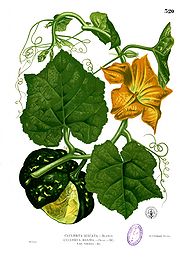The Great Pumpkin and Kin
By Audrey Stallsmith

For pottage and puddings and custard and pies,
Our pumpkins and parsnip are common supplies:
We have pumpkins at morning and pumpkins at noon,
If it were not for pumpkins, we should be undoon.
Pilgrim rhyme--1630
The pumpkin, with its vivid color and mellow flavor, is an apt symbol of autumn. Its flickering face lights Halloween night and its cinnamon-laced pies scent Thanksgiving morning. As indicated in the poem, this winter squash---technically a fruit---also sustained the Pilgrims through some grueling winters.
Squashes originated, like potatoes and tomatoes, in the Americas. I am beginning to wonder what Europeans ate before they discovered the New World!
The official name for all squashes, Cucurbita pepo, derives from the Latin for "gourd" and the Greek pepon. Depending on whom you believe, pepon means either “ripe,” “mellow,” “cooked by the sun,” or “large melon.” Squash derives, more simply, from the Algonquin Indian askoot asquash or “eaten green.”
So-called “summer” squashes such as zucchini and crookneck are simply those that are harvested at an immature stage, while their skins are still tender. If left to age, they can become almost as thick-skinned and warty as the “winter” squash (AKA Cucurbita maxima) pictured above!
Native Americans roasted and dried pumpkin strips and used them to make everything from sleeping mats to flour. They also brewed the crushed seeds into a tea to treat such afflictions as edema, gout, kidneystones, and bladder infections.
Although Columbus carried pumpkin seeds back with him to Europe, the squashes grown from them were initially fed to pigs! Shakespeare himself did not seem much impressed with the new “fruit.” In the Merry Wives of Windsor, a character says scornfully of Falstaff, “Go to, then: we'll use this unwholesome humidity, this gross watery pumpion. . .”
The original Jack-O-Lanterns were not carved from pumpkins. They derived from an Irish fable about a wiley lad called Stingy Jack, who tricked the devil into promising not to take his soul. Unfortunately, however, heaven didn’t want Jack either! So he was doomed to wander the earth, his way lit only by a coal from hell inside a carved-out turnip.
Superstitious folks carved scary faces on their turnips, potatoes, or beets and set them in their windows to ward off Jack and other wandering spirits. The colonists must have concluded that pumpkins made much more intimidating faces!
Washington Irving’s "The Legend of Sleepy Hollow" contributed to the pumpkin’s spooky reputation with the following: “. . .the tracks of horses’ hoofs deeply dented in the road, and evidently at furious speed, were traced to the bridge, beyond which, on the bank of a broad part of the brook, where the water ran deep and black, was found the hat of the unfortunate Ichabod, and close beside it a shattered pumpkin.”
Settlers also hollowed out pumpkins to fill them with milk, spices, and honey, and roast them in hot ashes. Voila! A pudding very similar to pumpkin pie! The flesh of pumpkin and other winter squashes also flavors delectable and highly nutritious soups, sweet breads, cakes, and muffins. Because they are high in beta-carotene, these tawny treats may even help prevent cancer.
Herbalists also recommend pumpkin for the elimination of intestinal parasites (worms), prostrate problems, and dizziness. John Heinerman touts a syrup made from combining ground up pumpkin seeds—known as pepitas--with honey or molasses to treat the first two maladies. James Duke explains that it is probably the seeds’ high levels of zinc, amino acids, and cucurbitacins that makes them effective against prostate problems.
Applied to the skin, cold mashed pumpkin or winter squash soothes mild burns, sunburns, headaches, and neuralgia. The crushed leaves have been used as a poultice for sprains and bruises.
And, of course, in story and rhyme, pumpkins have come in handy for everything from containing pumpkin-eaters’ wives, to “coaching” Cinderella, to terrifying irksome schoolmasters. But, to someone like me who is partial to pumpkin “pottage and puddings and custard and pies,” that can seem like a dreadful waste of the main ingredient!
Cucurbita maxima image is from Flora de Filipinas, courtesy of Wikipedia.








